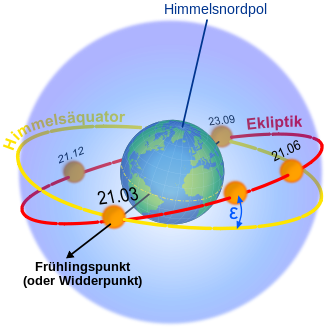Spring equinox
As equinoctial in to astronomy , the intersections of the celestial equator with the ecliptic called, where the sun at the equinoxes is. This happens worldwide at the beginning of spring and the beginning of autumn . According to the beginning of the season in the northern hemisphere , these points are called the vernal equinox and autumn equinox . The earth's axis is then exactly perpendicular to the line connecting the centers of the earth and the sun, and the equinox occurs on earth. The equinox denotes both the point in time and the previously defined point of intersection.
The vernal equinox is an important reference point in astronomy, especially in the geocentric equatorial coordinate system . By definition, it is infinitely far away. The direction to it is therefore the same from every point in the earth's orbit . Due to the precession , the vernal equinox moves steadily in a westerly direction on the ecliptic and takes about 25,800 years for a full cycle .
Mean equinox points
The two points on the ecliptic at which the Sun is in long-term average is at true equinox will, Aries point and balance point called because it the beginning of the zodiac sign Aries ( ![]() ) and scale mark on the ecliptic. This means that the beginning of the signs of the zodiac is independent of the precession .
) and scale mark on the ecliptic. This means that the beginning of the signs of the zodiac is independent of the precession .
See also
literature
- Andreas Guthmann: Introduction to celestial mechanics and ephemeris calculus. 2nd edition, Spectrum, Heidelberg 2000, ISBN 3-8274-0574-2 .
- Oliver Montenbruck: Basics of the ephemeris calculation . 7th edition, Spectrum, Heidelberg 2009, ISBN 978-3-8274-2291-0 .
- Manfred Schneider: Himmelsmechanik , 2nd edition, Bibliographisches Institut, Mannheim / Vienna / Zurich 1981, ISBN 3-411-01619-1 .
Individual evidence
- ↑ Jürgen Hamel : Concepts of Astrology . Harri Deutsch publishing house, Frankfurt am Main 2010, p. 263.
